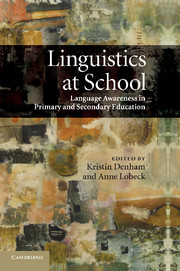Book contents
- Frontmatter
- Contents
- Notes on contributors
- Foreword: The challenge for education
- Introduction
- Part I Linguistics from the top down: encouraging institutional change
- Part II Linguistics from the bottom up: encouraging classroom change
- Part III Vignettes: voices from the classroom
- Introduction to Part III
- 16 And you can all say haboo: enriching the standard language arts curriculum with linguistic analysis
- 17 Code switching: connecting written and spoken language patterns
- 18 A primary teacher's linguistic journey
- 19 Why do VCE English Language?
- 20 Language lessons in an American middle school
- 21 The diary of Opal Whiteley: a literary and linguistic mystery
- 22 Using the Voices of North Carolina curriculum
- 23 A-level English Language teaching in London
- References
- Index
17 - Code switching: connecting written and spoken language patterns
Published online by Cambridge University Press: 04 August 2010
- Frontmatter
- Contents
- Notes on contributors
- Foreword: The challenge for education
- Introduction
- Part I Linguistics from the top down: encouraging institutional change
- Part II Linguistics from the bottom up: encouraging classroom change
- Part III Vignettes: voices from the classroom
- Introduction to Part III
- 16 And you can all say haboo: enriching the standard language arts curriculum with linguistic analysis
- 17 Code switching: connecting written and spoken language patterns
- 18 A primary teacher's linguistic journey
- 19 Why do VCE English Language?
- 20 Language lessons in an American middle school
- 21 The diary of Opal Whiteley: a literary and linguistic mystery
- 22 Using the Voices of North Carolina curriculum
- 23 A-level English Language teaching in London
- References
- Index
Summary
It's the beginning of second semester, the first day back from winter break, and we can sense they are tired as they slowly shuffle into the room seeming to have cement in their shoes. Greeting them at the door, we smile and announce that today we will start our writing block with a code switching lesson. Then we see that spark, the excitement that comes with learning new material! The students begin to arrange the chairs in our typical semi-circle fashion around the chalkboard and charts. Grabbing pens, white boards, and their new code switching notebooks, they jump into their seats ready to hear about code switching. Before our winter break we had told them we would be learning a new writing strategy. They were intrigued by the words code switching and were looking forward to the new lessons. We assured them it was something they had never heard before and that they would find the new method to be a very useful tool to improve their own writing. With the state writing test right around the corner they willingly committed to the new learning adventure.
We became invested in code switching in the fall of 2006. We felt strongly about including code switching in our 2006–2007 school accountability plan that drives our instructional year. We are both literacy teachers with Norfolk Public Schools and after receiving staff development on code switching from our English Department, we decided to introduce the concept to our Larchmont teachers.
Information
- Type
- Chapter
- Information
- Linguistics at SchoolLanguage Awareness in Primary and Secondary Education, pp. 240 - 243Publisher: Cambridge University PressPrint publication year: 2010
Accessibility standard: Unknown
Why this information is here
This section outlines the accessibility features of this content - including support for screen readers, full keyboard navigation and high-contrast display options. This may not be relevant for you.Accessibility Information
- 1
- Cited by
